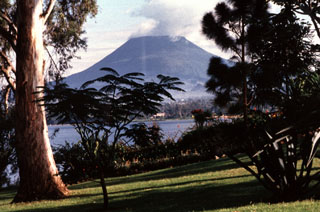Report on Nyiragongo (DR Congo) — June 2004
Bulletin of the Global Volcanism Network, vol. 29, no. 6 (June 2004)
Managing Editor: Richard Wunderman.
Nyiragongo (DR Congo) Significant ash plumes up to 6 km altitude and extending 185 km
Please cite this report as:
Global Volcanism Program, 2004. Report on Nyiragongo (DR Congo) (Wunderman, R., ed.). Bulletin of the Global Volcanism Network, 29:6. Smithsonian Institution. https://doi.org/10.5479/si.GVP.BGVN200406-223030
Nyiragongo
DR Congo
1.52°S, 29.25°E; summit elev. 3470 m
All times are local (unless otherwise noted)
When last reported on, activity at Nyiragongo remained at relatively low levels, with the continued presence of an active lava lake inside the crater (BGVN 28:12). Continued activity in May and June 2004 was characterized by weak emissions that produced ash plumes to various heights.
Activity during May 2004. The Toulouse VAAC reported that satellite imagery showed a weak eruption of Nyiragongo on 21 May. Activity intensified during the evening of 24 May, with thermal anomolies and aerosol plumes visible in true- and false-color satellite imagery on 25 May (figure 32). By the evening of 25 May, the plume was no longer visible on satellite imagery due to meteorological clouds in the area. The Toulouse VAAC reported that during 26 May to 1 June there were weak but steady emissions from both Nyiragongo and neighboring Nyamuragira (~ 13 km NW of Nyiragongo). The Goma Volcano Observatory confirmed that ash fell within a radius of 60 km of both volcanoes.
Activity during June 2004. A series of plumes were noted, several to estimated altitudes of over 5 km. On 4 June a new eruption began at Nyiragongo, producing a plume that probably contained ash. It rose to ~ 6 km altitude and stretched ~ 150 km SW. By 5 June the plume extended 185 km SW and was under ~ 4 km altitude. On 6 June, satellite imagery showed only a moderate plume stretching to the SW and a disconnected remnant of the earlier plume. The moderate plume, drifting SW, remained through 7 June. An ash plume extended ~ 75 km SW at ~ 5.5 km altitude on 8 June. During 9-15 June, ash from Nyiragongo was sometimes visible on satellite imagery below ~ 5.5 km altitude drifting WSW. Satellite imagery suggested that the ash emissions that began on 4 June ceased by 22 June.
Geological Summary. The Nyiragongo stratovolcano contained a lava lake in its deep summit crater that was active for half a century before draining catastrophically through its outer flanks in 1977. The steep slopes contrast to the low profile of its neighboring shield volcano, Nyamuragira. Benches in the steep-walled, 1.2-km-wide summit crater mark levels of former lava lakes, which have been observed since the late-19th century. Two older stratovolcanoes, Baruta and Shaheru, are partially overlapped by Nyiragongo on the north and south. About 100 cones are located primarily along radial fissures south of Shaheru, east of the summit, and along a NE-SW zone extending as far as Lake Kivu. Many cones are buried by voluminous lava flows that extend long distances down the flanks, which is characterized by the eruption of foiditic rocks. The extremely fluid 1977 lava flows caused many fatalities, as did lava flows that inundated portions of the major city of Goma in January 2002.
Information Contacts: Tolouse Volcanic Ash Advisory Center (VAAC), Toulouse, Météo-France, 42 Avenue G. Coriolis, 31057 Toulouse Cedex, France (URL: http://www.meteo.fr/vaac/); Goma Volcano Observatory, Departement de Geophysique, Centre de Recherche en Sciences Naturelles, Lwiro, D.S. Bukavu, DR Congo.


